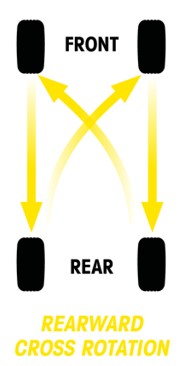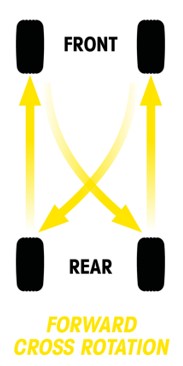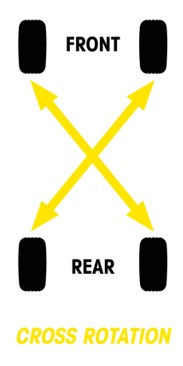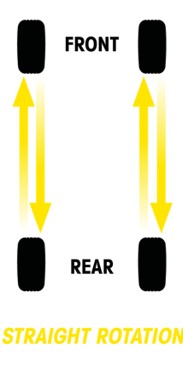Car tyres will wear more quickly depending on where they are positioned on your car. So to extend the life of your tyres, you should rotate them roughly every 6000 miles for cars or 4000 miles for 4x4 vehicles.

How you rotate your tyres depends on whether you’re driving a front wheel drive, rear wheel drive or 4x4.
The diagrams below show the various ways car tyres can be rotated.
Staggered Tyres
Some vehicles have staggered tyres, where the tyres on the rear axle are not the same size as the tyres on the front axle. In this situation, tyres can only be rotated right to left and left to right, not front to back.

Front Wheel Drive Tyre Rotation

Rear Wheel Drive Tyre Rotation

Four Wheel Drive Tyre Rotation

Straight Rotation for Directional Tyres
If you have directional tyres on your car, these tyres can only be rotated from front to back, but not crossed. This is known as a straight rotation, where the front left tyre exchanges position with the rear left tyre and the front right tyre exchanges position with the rear right tyre.
Rotating your tyres is necessary to get the most miles out of your tyres. Depending on what type of car you drive, some of your tyres are likely to wear out quicker than others. By rotating your tyres every 6000 miles or so, you can spread the rate at which your tyres wear across all four tyres, allowing you to get the most out of the tyre’s tread life.
Note: rotating your tyres won’t correct wear problems caused by incorrect inflation pressures or irregular wear as result of poor wheel alignment.
Rotating your car tyres has key benefits:
You should rotate your tyres every 10,000km / 6,000 miles or so. There are additional factors that may mean you need to rotate your tyres more frequently:
We always recommend getting a professional to rotate your car tyres for you.
If you’re confident that you can rotate your car tyres yourself, remember to use the correct torque spec when tightening up tyres and wheels. You can find this information in your owner’s manual. It is important to ensure that your wheels are properly tightened after any rotation or tyre change.